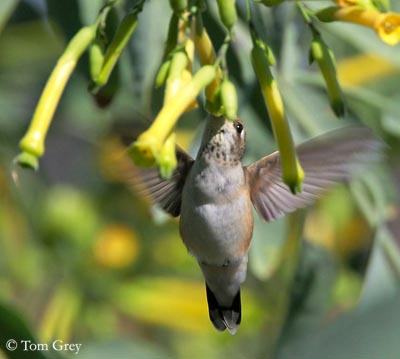
Black-chinned Hummingbird
Archilochus alexandri
Apodiforme Order – Trochilidae Family
BIOMETRICS:
Length: 9 cm
Wingspan: 11 cm
Weight: M: 3g- F: 3,4 g
Fr: Colibri à gorge noire
All : Schwarzkinnkolibri
Esp : Colibrí Gorginegro
Ital : Colibri Golanera
Nd : Zwartkinkolibrie
Sd : Svarthakad Kolibri
Photos by Tom Grey
Tom Grey's Bird Pictures
Photos by Tom Merigan
Tom Meriganís Photo Galleries
Photos by Alan & Ann Tate
AA Bird Photography
Text by Nicole Bouglouan
Sources:
HANDBOOK OF THE BIRDS OF THE WORLD Vol 5 by Josep del Hoyo-Andrew Elliott-Jordi Sargatal - Lynx Edicions - ISBN: 8487334253
A GUIDE TO THE BIRDS OF MEXICO AND NORTHERN CENTRAL AMERICA by Steve N. G. Howell, Sophie Webb - Oxford University Press - ISBN: 0198540124
BIRDS OF THE GREAT BASIN – by Fred A. Ryser - Univ of Nevada Pr -ISBN: 0874170796
FIELD GUIDE TO THE BIRDS OF NORTH AMERICA - National Geographic Society - ISBN: 0792274512
All About Birds (Cornell Lab of Ornithology)
What Bird-The ultimate Bird Guide (Mitchell Waite)
Wikipedia (Wikipedia, The Free Encyclopedia)

DESCRIPTION:
Black-chinned Hummingbird is metallic green on upperparts. Male shows violet band at lower border of the black throat. Underparts are whitish, contrasting with dusky green sides and flanks.
It has a long and flat bill.

Female has white throat, or some dusky or greenish streaks on it. She also has white tips to tail feathers. It is larger than male and has buff sides.

Immature resembles to female. Immature male may show small violet patch on lower throat in fall.
VOICE:
Black-chinned Hummingbird’s call is a soft “tchew”. We can hear various high “chip” and “tick”.
HABITAT:
Black-chinned Hummingbird occupies various habitats, from urban areas to desert, and from lowlands and low mountains to 8000 feet high. But they prefer canyons or food-plains riparian habitat.
RANGE:
Black-chinned Hummingbird breeds from southern British Columbia to Mexico. It winters in Mexico.
BEHAVIOUR:
During breeding season, Black-chinned Hummingbird performs an elaborate courtship display. Male performs a series of U-shaped swoops, passing close to female at the bottom of its arc.
We can hear a whistling sound during the pendulum-like flight, made by its wings.
Male and female occupy different habitats during nesting season, male in drier areas, and female in canyon bottoms.

Black-chinned Hummingbird is very territorial, defending food sources and breeding or nesting areas. Males perch on a high branch, to watch for intruders, and giving a vocal warning to competitors. When it chases other birds during intimidation flights, it utters and excited chippering sound.
Before migration, Black-chinned Hummingbird must increase its body weight by 25 to 50 %, and in cold weather, it may ingest three times its body mass in nectar in one day.
To feed, Black-chinned Hummingbird catches flying insects on the wing, or gleans them from foliage.
FLIGHT:
Black-chinned Hummingbird, as all hummingbirds, has a unique skeletal structure. They can fly forwards, backwards, side to side, and on the back. They can hover and take off vertically.
Black-chinned Hummingbird flight requires about 50 beats per second and also massive muscles.

REPRODUCTION:
Black-chinned Hummingbird’s nest is located low in the canopy, at about 2 metres above the ground, in a drooping branch of a bush, or in a fork in a tree limb.
After mating, female builds the cup-shaped nest. It is a minute nest, woven with spider webs, and vegetal down and hair. When material is placed, female moulds the nest twirling around against the sides, pressing hard. This nest may stretch to double its size as the young grow, needing more space.
Female lays 2 tiny white eggs. Incubation lasts about 13 to 16 days by female. Young hatch altricial and fledge 21 days after hatching.
This species produces two clutches per season, sometimes three.
DIET:
Black-chinned Hummingbird feeds on nectar, pollen, insects and sugar water on feeders.

